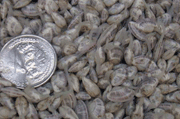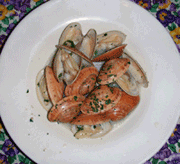
Purpose:
Over the past two decades, Florida has seen a dramatic increase in aquacultured shellfish production. The hard clam industry grew from $0.4 million (13 farmers) in 1987 to $19 million (336 farmers) in 2007. However, the industry is built on a single species whose value fell to just under $13 million in 2003 as dockside prices plummeted from 13¢ to 9¢ per clam during the 2001-2004 economic downturn, which was not reflected in other bivalve species, such as oysters. Diversifying the shellfish culture industry by developing farming technology and markets for other bivalve species may increase economic stability and growth of the industry. The sunray venus clam, Macrocallista nimbosa, is an attractive venerid clam distributed from South Carolina to Florida and the Gulf states. Commercial fishermen targeted the sunray venus clam in the late 1960s in several shallow water areas off the northwest Florida coast. Even though the large 4-7 inch clams were shucked and processed, commercial harvesting was halted due to the limited size of the fishing grounds. However, growth experiments using marked individuals suggested that these popular clams attain a length of three inches (40 g whole) within 12 months; similar in time to hard clams in Florida. The prior fishery, market and potential growth rate of the sunray venus, along with being a native species, made it a logical choice as a new species to diversify the Florida clam industry.
Approach:
The goal was to develop, test and demonstrate biological and technical methods to spawn and culture the sunray venus clam. The work was aimed at introducing a new molluscan species to shellfish producers, which would have the potential of providing a different revenue source to small-scale hard clam culture enterprises, thus improving farm income. The objectives were to utilize current hard clam methods as a starting point to: 1) identify methods for brood stock handling and spawning, 2) establish hatchery protocols for rearing embryos through larval metamorphosis, 3) grow a group of sunray venus clams from post-set to commercial size, 4) characterize financial considerations of hatchery production, and 5) test market perception of cultured sunray venus clams at restaurants.
Results:
Seed Production: Adult sunray venus clams were collected from natural assemblages near St. Teresa Beach and Seahorse Key, Florida and shipped to the HBOI-FAU experimental mollusk hatchery by overnight courier. Clams were then placed either in aragonite substrate or no substrate in temperature-controlled tanks (20-25oC, 30-32 ppt), fed microalgae daily, and observed for mortality. Brood stock clams did not exhibit excessive mortality from overnight shipping (i.e., <11% after one week). Histological analysis of gonad tissue indicated an approximate 1:1 female to male ratio. Induced spawning was attempted using thermal-cycling (10oC increase) and sperm-addition, which resulted in the first ever successful induced spawning of both male and female sunray venus clams in November 2006. Approximately one month later a second induced spawn was accomplished using thermal-cycling and serotonin injection. Both spawns yielded viable gametes that resulted in D-stage larvae the following day. Larvae were fed microalgae (Isochrysis sp., clone T-ISO) daily and water (30-31 ppt, 26-28oC) was changed daily. Larval development was similar to hard clams; pediveligers (~220 µm) were noted at day seven at which time they were placed in downwellers without or with substrate (sand, aragonite). Metamorphosis occurred over several days in all treatments. Settled clams were fed mixtures of T-ISO and a diatom and water was changed every other day. Three months after settlement, clams from both spawns were enumerated by volumetric sampling; groups in substrate had higher returns than without substrate. The first spawn exhibited a 63% total return and the second spawn exhibited a 46% total return. A feed density trial was initiated with juveniles to determine maximum cell density for growth. Triplicate 4-L beakers each containing 24 clams (42±3 mg) were fed 0, 50, 100, or 200 K cells/mL of Isochrysis sp. twice/day over a four-week period. Growth (absolute and % change) did not increase above the 100K cells/mL treatment. Filtration rates, in general, decreased with increasing cell density. Sunray venus clam seed were distributed to industry partners for further nursery culture in upwellers, downwellers, or sand-filled trays. In addition, about 86,000 seed (>2.0 mm sieve size, 48 per milliliter) were nursed in shallow trays within raceways at the UF nursery facility in Cedar Key. Over a 47-day nursery period, 73% of the seed sieved up on 4.0 and 6.0 mm screens.
Growout Production: Production performance of sunray venus clams under field nursery and growout conditions was examined during 2007-8. Sunray venus clam seed (about 118,000; 9.3-18.5 mm shell length, SL) were field-planted in nursery systems (soft bags and hard cages) at densities of 100-550/ft2. After 42-119 days, survival ranged from 32-94% and daily growth rate was 0.12-0.25 mm SL. Sunray venus juveniles (27 mm SL; 10 mm shell width, SW) were further cultured in hard cages and soft bags at densities of 42-55/ft2. After 11 months, sunray venus (61-67 mm SL, 22-23 mm SW, 30-37 grams total weight, 8.1-9.1 condition index) were harvested for market acceptance studies. Survival ranged from 50-82%. Field nursery and growout culture methods for sunray venus clams exhibited little difference from hard clam methods. Initial trial production efforts appeared successful; however, problems with shell deformities, which seemed to be substrate-related, must be resolved. This represented the first documentation of hatchery-produced sunray venus grown under culture conditions in open-water environments. Although the number of sunray venus clams produced was low, one group each from commercial shellfish aquaculture lease areas in two counties (Franklin and Levy) were cultured through potential market size. At the Cedar Key site, “market size” sunray venus (63 mm, SL; 22 mm, SW) were produced from post-set seed (>2.0 mm sieved seed, ~5 mm SL) in 16.3 months; whereas, hard clams require about 17 to 20 months to reach “littleneck” size (50 mm SL, 25 mm SW). These results provided guidelines for future efforts of researchers and shellfish growers.
Financial Considerations of Seed Production:The hatchery process employed for sunray venus clam seed production was similar to the process utilized for hard clam seed production. Similar costs may be expected to incur with respect to brood stock acquisition, energy to move and heat water, labor, algae, various supplies, capital cost of space for brood stock maintenance and spawning, and other expenses. However, there were some differences that may need to be utilized in the production of sunray venus clam larvae and seed. Sunray venus clam brood stock seemed to prefer being buried in a substrate, which limits the number of clams that can be placed in a system. Therefore, there would be an added expense of obtaining substrate (e.g., construction sand), containers (e.g., plastic dish pans) for the substrate, and a larger area for brood stock maintenance. The other difference noted was that production of post-set was greater (50-66%) in settlement systems with substrate (sand or aragonite) versus no substrate. This substrate effect was also noted in nursery seed growout. However, the need for substrate for larval metamorphosis and growth was not an absolute necessity. A hard clam hatchery operator noted that substrate improves hard clam settlement numbers, too; but the problems associated with substrate (e.g., anoxic pockets, cleaning problems that lead to fouling) in a hatchery and early nursery are more trouble that the reduced survival and growth. Although substrate is probably a necessity for brood stock maintenance, all other aspects of sunray venus clam hatchery procedures and expenses may be similar or only marginally different as compared to those associated with hard clams.

Consumer Acceptance: The market acceptance of the cultured sunray venus clam was demonstrated within the north Florida market area. A group of four restaurants agreed to participate in a consumer acceptance study. Each restaurant received a given number of cultured sunray venus clams (average shell length, 53-65 mm or 2.1-2.6”; average weight, 23-37 g or12-20/lb) each week for a period of four weeks (October 2008). The chefs in each restaurant were allowed to serve the clams utilizing any preparation manner they chose and to charge any price they wished. Most clams were served steamed, baked, or broiled. The wait staff were instructed to ask each patron who consumed the clams to complete a brief tableside survey. The survey solicited the patron’s reaction to various attributes of the sunray venus clams they just consumed, as well as some respondent demographic information. Within participating restaurants, 239 patrons tried sunray venus clams and completed surveys. Most respondents were only slightly hesitant to try cooked sunray venus clams. Only 11% of the respondents detected any grittiness in the clams. For all respondents, 94% were willing to order the product again, and 97% were willing to recommend the product. The survey findings provided insight into the acceptance of cultured sunray venus clams as a viable seafood product and the willingness of consumers to purchase the product.
A number of presentations about project results have been made at state, regional, and national meetings. The presentations and final reports below can be viewed in PDF format.
- John Scarpa, Leslie Sturmer, Jose Nunez, and LeRoy Creswell. 2008. Evaluation of the Sunray Venus Clam for Florida Aquaculture: Seed Production. Presented at the Florida Clam Industry Workshop, Cedar Key, FL and Aquaculture America, Orlando, FL.
- Leslie Sturmer, John Scarpa, and LeRoy Creswell. 2009-10. Evaluation of the Sunray Venus Clam for Florida Aquaculture: Growout Production. Presented at the Florida Clam Industry Workshop, Cedar Key, FL and triannual conference of the World Aquaculture Association, San Diego, CA.
- Chuck Adams, Leslie Sturmer, John Scarpa, and Dan Brian. 2008-9. Evaluation of the Sunray Venus Clam for Florida Aquaculture: Consumer Acceptance. Presented at the Florida Clam Industry Workshop, Cedar Key, FL and annual conference of the National Shellfisheries Association, Savannah, GA.
- John Scarpa, Leslie Sturmer, Chuck Adams, Jose Nunez, and LeRoy Creswell. 2009. Sunray Venus Clams: A New Species to Diversify the Florida Clam Aquaculture Industry. Final report to Florida Sea Grant, 23 pp.
- Chuck Adams, Leslie Sturmer, and John Scarpa. 2009. Market Assessment of Cultured Sunray Venus Clams. Final report to Florida Sea Grant, 16 pp.
The video Spawning and Early Culture of the Sunray Venus Clam, illustrating seed production and documenting sunray venus clam development, can be viewed below:
Investigators and Partners:
- John Scarpa, Harbor Branch Oceanographic Institute at Florida Atlantic University (HBOI-FAU)
- Leslie Sturmer, University of Florida (UF) IFAS Shellfish Aquaculture Extension
- Chuck Adams, University of Florida IFAS Food Resource and Economics Department
- Jose Nunez, University of Florida, The Whitney Lab
- LeRoy Creswell, University of Florida, Florida Sea Grant
- Florida Seed Producers: Blue Acres, Kevin Reinecke; Ewan Leighton
- Florida Clam Growers: Van Lewis, St. Teresa Shellfish; Johnny Sheridan, Andy Arnold
- North Florida Restaurants: Avenue Sea at The Gibson Inn; Ballyhoo Grill; Campbell Seafood; The Island Room
Funding:
- Florida Sea Grant College Program, R/LR-A-44, 2006 – 2009



